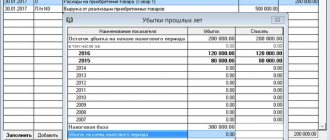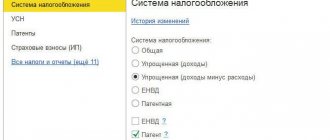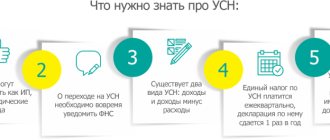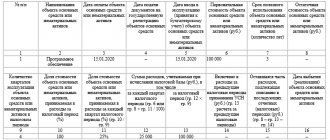Recognizing future expenses
The main task when accounting for BPR is to differentiate costs between expenses and assets, which are subsequently allocated into a separate object of the same name. Recognition of assets as deferred expenses is determined by its controllability by the company and the possibility of obtaining from it the economic benefits that it will bring if:
- used in the production of products/services for sale independently or together with other assets;
- exchanged for another asset;
- suitable for repaying obligations.
These features serve as a kind of indicator that allows you to attribute costs to BPR as an asset. As a rule, the company forms criteria for such attribution (usually by type/item of costs, taking into account industry characteristics) and is enshrined in the section defining the rules of accounting and accounting policies.
Conditions for accounting for expenses according to the simplified tax system
All expense business operations of simplified taxation system payers can be divided into five groups:
- purchasing goods for resale;
- acquisition of materials and raw materials to perform work;
- purchase of services and works of third-party contractors (rent of premises, equipment);
- creation, purchase and commissioning of fixed assets;
- purchase of equipment, tools or other property less than 100 thousand rubles.
Under the simplified tax system, expenses can be taken into account only after actual payment (clause 2 of article 346.17 of the Tax Code of the Russian Federation). But that's not all. In order for a taxpayer to take expenses into account in the tax base, additional conditions must be met, different for each of the listed groups.
Keep track of expenses, prepare and submit reports according to the simplified tax system via the Internet
Purchasing goods for resale
Taxpayer expenses for goods purchased for subsequent resale are taken into account only if the following conditions are met in aggregate:
- The goods were sold to the buyer (clause 2, clause 2, article 346.17 of the Tax Code of the Russian Federation). You can sell them, including with a deferred payment; you don’t need to wait for the receipt of money to be taken into account in expenses (Clause 1 of Art. Tax Code of the Russian Federation, Clause 1 of Article 223 of the Civil Code of the Russian Federation, letter of the Ministry of Finance of the Russian Federation dated September 23, 2019 No. 03-11- 11/73036).
- The goods have been paid to the supplier (letter of the Federal Tax Service of Russia dated December 6, 2010 No. ШС-17-3/ [email protected] ).
- The costs of purchasing goods are confirmed by primary documents.
How to carry forward expenses to a future period
Agree with the supplier to defer payment until January next year. Another option is to reserve the goods and pay in advance, but ship only after the end of the tax period. The advance payment is not taken into account in expenses, but will help to fix the cost or availability of purchased products (letter of the Ministry of Finance of the Russian Federation dated May 20, 2019 No. 03-11-11/36060).
Purchase of materials and raw materials (MPR) to perform work
Costs for the acquisition of raw materials and supplies are taken into account as expenses at the time of actual payment or repayment of debt in another legal way, for example, offsetting mutual homogeneous claims (clause 1, clause 2, article 346.17 of the Tax Code of the Russian Federation, letter of the Ministry of Finance of the Russian Federation dated November 26, 2019 No. 03- 11-11/91390).
At the moment of reflecting the costs of inventories in accounting, inventories must be capitalized into the warehouse. In this case, the actual date of use of the MPZ in the production process does not matter (letter of the Ministry of Finance of the Russian Federation dated July 31, 2013 No. 03-11-11/30607).
How to carry forward expenses to a future period
Obtain the supplier's consent to reschedule delivery or defer payment until the beginning of next year.
Purchasing services and work from third party suppliers
Services and work of third-party suppliers are taken into account in expenses only after payment and confirmation of the completion of work or provision of services (clause 2 of Article 346.16, clause 2 of Article 346.17 of the Tax Code of the Russian Federation). The completion of work is confirmed by an act drawn up according to accounting rules; the provision of services can be confirmed by another primary document (report, invoice, invoice, etc.), if this is enshrined in the accounting policy or in the agreement between the parties (letter of the Ministry of Finance of the Russian Federation dated January 21, 2019 No. 07-04-09/2654).
How to carry forward expenses to a future period
Check in the contract what confirms the completion of work or provision of services. Agree with the contractor to postpone payment to January or the date of issuing a certificate of completion or other document that confirms the provision of the service.
Expenses for the creation, purchase and commissioning of fixed assets
Fixed assets (FPE) are property used in the production or management process, the cost of which exceeds 100 thousand rubles and the useful life of which is more than one year (clause 1 of Article 257 of the Tax Code of the Russian Federation).
You can take into account the costs of creating, purchasing or commissioning an OS only after they have been fully paid for and put into operation. If the payment is incomplete, only part of the expenses can be taken into account (letter of the Ministry of Finance of the Russian Federation dated August 28, 2018 No. 03-11-06/2/61172).
Another prerequisite is that expenses must be economically justified and aimed at generating income.
If the payer combines the simplified tax system with another tax regime and purchased fixed assets that will be used only within the framework of another regime, for example, PSN, then costs cannot be included in expenses (clause 8 of article 346.18 of the Tax Code of the Russian Federation, letter of the Ministry of Finance of the Russian Federation dated May 31, 2018 No. 03 -11-11/37046).
Expenses for fixed assets are written off during the calendar year in equal shares on the last day of each remaining quarter and at the end of the year (clause 3 of article 346.16, clause 4 of clause 2 of article 346.17 of the Tax Code of the Russian Federation, letter of the Federal Tax Service of Russia dated February 27, 2010 No. 3- 2-11/ [email protected] ).
For example, if all the conditions for recognizing expenses are met in the first quarter, expenses are recognized in equal shares on March 31, June 30, September 30 and December 31 of this year. And if commissioning was carried out only in the fourth quarter, the entire amount of costs will be expensed on December 31.
How to carry forward expenses to a future period
Postpone payment or commissioning of the fixed asset until the beginning of next year.
In case of claims from tax authorities, prepare a documentary substantiation of the reasons why the operating systems were put into operation later than purchased. Such reasons may be repairs, debugging, technical defects during installation. Gather a commission and draw up an act in which you indicate the reasons why the object cannot be used in the production process. Make a list of necessary works and a schedule for their implementation. Put the OS into operation in the new year, after eliminating the reasons preventing their use in production. An important nuance is that depreciation on fixed assets can only be calculated after commissioning.
Expenses for the purchase of equipment, tools or other property less than 100 thousand rubles
Low-value property is tools, fixtures, equipment, instruments, laboratory equipment, workwear, personal and collective protective equipment and other property that costs less than 100 thousand rubles and is not depreciable.
The taxpayer establishes the method of reflecting the value of low-value property in expenses in the accounting policy. Such property can be fully included in expenses upon transfer to operation, or it can be depreciated, as in accounting (clause 2 of Article 254 of the Tax Code of the Russian Federation, letter of the Ministry of Finance of the Russian Federation dated March 6, 2019 No. 03-03-07/14527). In both cases, low-value property must be paid in full by the time its value is reflected in expenses.
What applies to deferred expenses?
PBU defines two types of costs that can be recognized as part of the RBP:
- expenses spent on future construction. For example, materials sent to the construction site;
- licensed software.
In addition, there are specific costs that a company can recognize as a PBU, since none of the PBUs indicate how to account for them, but, logically, they should be written off gradually over a certain time. Such costs, for example, include the following:
- for preparation for work (maintenance of equipment and mechanisms) in seasonal industries;
- to master the production of the latest types of consumer goods;
- for land reclamation;
- for the transfer of company divisions;
- for product certification or compulsory/voluntary health insurance.
Disputes with the tax authorities
Very often, companies have a disagreement with the fiscal authorities regarding the deduction of VAT on expenses relating to several periods. Employees of the Ministry of Finance explained that collection amounts presented to a company for goods (works, services), the costs of which are not standardized for the purpose of calculating income tax, but are taken into account evenly over a certain period, are accepted for deduction in full in the generally established manner (Letter from 05.10.2011 No. 03-07-11/261). Thus, one should be guided by the rules that are prescribed in Article 271 of the Tax Code of the Russian Federation.
The upcoming expenses should not include the costs of licensing, product certification, vacation pay for employees due for the next month, transfers for the repair of fixed assets if there is no reserve for this in the company. These amounts must be taken into account in the current period even if they can significantly reduce the financial performance of the company or even lead to a loss. This conclusion can be made on the basis of Letter of the Ministry of Finance dated September 6, 2011 No. 07-02-06/166.
Irina Sidorova, expert at Calculation magazine
Deferred expenses in tax accounting
Tax legislation does not provide for the concept of BPR, but there is a special procedure for recognizing certain costs. For example, such expenses include financing for the development of natural resources, R&D, property insurance, and loss arising from the sale of depreciable assets (Articles 261,262,263,268 of the Tax Code of the Russian Federation).
The Tax Code of the Russian Federation establishes that expenses are recognized as such in the reporting period in which they arise from the terms of agreements or transactions. If the documents confirm that the costs relate to a number of periods, then the payer will have to take them into account when calculating the income tax for the entire specified period.
For example, a one-time payment for the right to use a brand is included in taxable expenses in equal shares for the duration of the license agreement.
If it is impossible to determine the period of occurrence of costs from the terms of the transaction, then the company has the right to independently establish the write-off period, having previously fixed the distribution procedure in the tax section of the accounting policy.
Is it possible to carry forward expenses to future periods at your discretion?
One of the options for getting rid of losses in a declaration under the simplified tax system is to transfer expenses to future periods. However, you cannot, at your own discretion, simply take and reflect expenses in the next tax period. To do this, you need to carefully analyze your business transactions from the point of view of fulfilling the conditions for their accounting.
Sometimes accountants play tricks and “find” documents for the previous year after it has ended. But it is safer to take into account expenses in the period to which they relate. They can be reflected in the current period only when it is not possible to determine the period of the error or when the error led to an overpayment of tax (Clause 1 of Article of the Tax Code of the Russian Federation).
Having discovered an error, the accountant must assess how it affected the tax base of the previous period - it led to an overpayment or underpayment of tax on the simplified tax system. And then, based on the situation, submit an updated declaration for the previous period or reflect the correction in the current declaration.
The “trick” will not work when, at the end of the year, the minimum tax has been paid, calculated based on the income received (clause 6 of Article 346.18 of the Tax Code of the Russian Federation). Having discovered expenses incurred last year, but taken into account when calculating the simplified tax system tax in the current year, the tax office will exclude such expenses from the tax base and charge additional tax.
Postings to account 97 “Deferred expenses”
Since RBPs are an asset, the debit of account 97 records the amount of funds spent (for example, to obtain a certificate), and the credit records the write-off of these expenses in a certain time period (for example, the validity period of the document).
Deferred expenses are accounted for in accounting as follows:
- D/t 97 K/t 51 (60) – for the amount of costs accounted for as RBP;
- D/t 20 (26, 44, 91) K/t 97 – for parts written off in each period.
In the balance sheet, RBP are reflected as a separate item on line 1210 “Inventories” or line 1260 as part of other current assets. To confirm the timeliness and correctness of their write-off, companies periodically conduct an audit of deferred expenses , in which they reconcile the amount of turnover and account balances with the information from primary accounting documents.
VAT recovery
The second important question: is it necessary to restore the amount of tax previously accepted for deduction? The right to refund “input” VAT arises if the conditions defined by subparagraph 1 of paragraph 2 of Article 171 of the Tax Code of the Russian Federation are met: the acquired asset or service must participate in activities subject to VAT. Organizations using the simplified tax system are not payers of this tax, therefore the balance of future expenses will not be used in accounting (clause 2 of article 346.11 of the Tax Code of the Russian Federation).
Clause 3 of Article 170 of the Tax Code of the Russian Federation obliges companies, when switching to the simplified tax system, to restore VAT on the cost of goods (work, services) remaining on the balance sheet, as well as on the residual value of fixed assets and intangible assets. The transfer is subject to the fee accepted for deduction in classical accounting. These actions are carried out on the eve of a regime change. The restored amounts are included in the declaration for the last quarter in which the organization applied the general regime. In this case, the tax amount is taken into account as part of other expenses (Article 264 of the Tax Code of the Russian Federation).
The upcoming expenses should not include the costs of licensing, product certification, vacation pay for employees due for the next month, transfers for the repair of fixed assets if there is no reserve for this in the company.
Future expenses under the simplified tax system
Accounting for RBP is usually carried out by companies using OSNO. “Simplers” do not work with account 97. When switching to the simplified tax system, the balances of the RBP amounts (if they exist) are written off in full as expenses and reflected in the KUDiR. However, it is not always possible to take such expenses into account when calculating the single simplified tax. It depends on the moment of payment of these costs. If deferred expenses were paid before the transition to the simplified tax system, then they cannot be taken into account as expenses that reduce the tax base, since only the document paid for in the reporting period is recognized as an expense of a simplified enterprise.
If the company pays for the RBP after the transition to the simplified tax system, then it has the right to take these costs into account as expenses. True, this is only possible when the expenses are listed in Article 346.16 of the Tax Code of the Russian Federation.
What is the threat of a loss in a declaration under the simplified tax system?
Having discovered losses in the declaration under the simplified tax system, employees of the office department of the Federal Tax Service will ask the company or individual entrepreneur for an explanation of the reasons (Clause 3 of Article of the Tax Code of the Russian Federation).
The tax authorities’ request must be responded to within five working days. If you are late or provide false information, the head of the company will be called to personally answer questions. Unprofitable declarations under the simplified tax system for two years in a row may cause an on-site inspection (Order of the Federal Tax Service of Russia dated May 30, 2007 No. MM-3-06 / [email protected] ).
In addition to the risk of audit, a business with unprofitable statements has difficulties when lending or participating in tenders. Banks and private investors refuse to give money to companies with such financial indicators. When conducting tenders, the provision of financial statements and profit declarations are key requirements that demonstrate the tax reputation of a bona fide company.
Submit your declaration under the simplified tax system online for free
Revenue recognition rules
The moment of recognition of income under the simplified tax system “income” does not differ from the procedure for their recognition under the simplified tax system “income - expenses”. The procedure for recognizing income under the simplified tax system is prescribed in paragraph 1 of Art. 346.17 Tax Code of the Russian Federation. For the simplified taxation system, the cash method is used.
The date of recognition of income under the simplified tax system “income - expenses” is the day the money is received in a bank account or at the cash desk. If repayment of debt or other material benefit is received in the form of other property, work, services or property rights, then it must be taken into account at the time of their receipt.
For example, when repaying a buyer's debt for goods by offset, the receipt of funds must be taken into account on the date of offset of counterclaims.
1C Accounting - accounting of business transactions in detail!
subscribe to blog updates via e-mail
Hello dear readers of the blog-buh blog. Today we will once again get acquainted with another regulatory operation for closing the month , which is in the software product 1C Enterprise Accounting 8 edition 3.0 - it is called “Recognition of expenses for the acquisition of OS for the simplified tax system . The 1C ACCOUNTING program allows you to keep records not only under the general taxation system (OSN), but also under the simplified taxation system (USN). I will also note that it can be successfully used to keep records of individual entrepreneurs, but this is a slightly different conversation, so we will put it aside for now. In this article I will talk about some of the features of accounting under the simplified tax system and, using an example, I will tell you why the regulatory operation is used - “Recognition of expenses for the acquisition of fixed assets for the simplified tax system.”
Let me remind you that the site already has a number of articles that are devoted to the issue of closing a month in the 1C BUKH 3.0 program:
- Part 2: “Closing accounts 20, 23, 25, 26” transactions: detailed analysis of “Closing the month” in 1C ACCOUNTING 3.0
- Part 1: “Closing accounts 20, 23, 25, 26” transactions: detailed analysis of “Closing the month” in 1C ACCOUNTING 3.0;
- “Adjustment of item cost”;
- “Revaluation of foreign currency funds”;
- “Calculation of trade margin”;
- “Recognition of expenses for the acquisition of OS for the simplified tax system”;
- “Write-off of additional expenses for the simplified tax system”;
- “Calculation of shares of write-off of indirect expenses”;
- “Calculation of transport tax”;
- “Calculation of land tax”;
- “Calculation of property tax”;
- “Write-off of deferred expenses”;
- “Repayment of the cost of workwear and special equipment”;
- Accounting for depreciation of fixed assets;
- Exclusion of work in progress from the composition of material costs for the simplified tax system;
- Methods of depreciation of fixed assets in 1C Accounting.
Setting up accounting policies for simplified taxation purposes
Before we begin reviewing the current issue, I would like to talk a little about how to set up 1C ACCOUNTING edition 3.0 to account for the Simplified Taxation System (STS). To do this, let's open the “Accounting Policy” (section of the main menu “Directories and Accounting Settings” in the “Taxi” interface). Set the “Taxation system” switch to “Simplified” and fill out the “STS” tab.
On this tab you need to specify the following fields:
- The date of transition to the simplified tax system is the first day of the year; You can switch to the simplified tax system from another taxation system only from the beginning of the year; I will not fill out this field, since our organization is not switching to the simplified tax system, but has just opened and is starting activities immediately on the simplified tax system;
- Notification of transition to the simplified tax system No. and date - notification of the transition must be submitted to the tax authority before December 31; I also don’t fill it out;
- To control the provisions of the transition period in accordance with clause 1 of Article 346.25 of the Tax Code of the Russian Federation - is established for organizations that, before the transition to the simplified tax system, had a special tax system and used the accrual method when calculating income tax.
- The object of taxation is two options: “income” at a rate of 6% or “income minus expenses” at a rate of 15%. For our example, the second option will be chosen;
- Procedure for recognizing expenses - a table opens in which recognition criteria are set by checkboxes.
- The basic procedure for reflecting advances from the buyer for tax purposes is that if the value “Income of the simplified tax system” is selected, then the advance will be recognized as income for the purposes of the simplified tax system, if the second value is selected, then the advance will not be considered income of the simplified tax system.
I will not go into detail about the remaining bookmarks, since they are individual for each organization and filling them out will not pose any special problems. Let us move on to the issue at hand.
Purchase of fixed assets under the simplified tax system
Let's consider the principle of operation of the regulatory operation “Recognition of expenses for the acquisition of OS for the simplified tax system” using the example of an organization that purchases an expensive server and accepts it for accounting as a fixed asset (FP).
| So, to begin with, our organization makes an advance payment to the supplier in the amount of 40,000 rubles. To do this, we generate the document “Write-off from the current account”. Filling out the document itself has no special features in connection with the simplified tax system. I would like to draw your attention to the document postings. In addition to the standard accounting entry Dt 60.02 <- Kt 51 in the amount of 40,000, the program generates movement in the register “Ledger of Income and Expenses (Section I) (1)”. |
In column 6 of this register the amount of our payment is entered - 40,000.
Next, using the document “Receipt of goods and services”, we reflect the purchase of equipment - Server - worth 100,000 rubles. We fill out the document in a standard way, there are no special features in connection with the simplified tax system. It forms a typical posting Dt 08.04 Kt 60.01 in the amount of 100,000 rubles. Also counts the advance payment Dt 60.01 Kt 60.02 – 40,000 rubles. It does not generate additional tax accounting entries.
| Now we create the document “Acceptance for accounting of fixed assets” . I wrote in detail about this document and about the depreciation of fixed assets in the article Accounting for depreciation of fixed assets: a detailed description of “Closing the month” in 1C ACCOUNTING 3.0. Therefore, now I will note only those features that relate to the simplified tax system. These features are present on the “Tax accounting (STS)” of the document “Acceptance for accounting of fixed assets”. There are several fields that must be filled in to correctly account for the costs of purchasing this OS in the simplified tax system: |
- Cost (amount of expenses of the simplified tax system) – indicate the total cost of the server 100,000 rubles;
- Date of acquisition – date of the document “Receipt of goods and services” 02/14/2014;
- Useful life – we indicate 36 months;
- The procedure for including the cost in expenses - if we select the option “Include depreciable property” , then the expenses for the purchase of fixed assets will, firstly, be included in Section 2 of the Book of Accounting for Income and Expenses (it is called “II. Calculation of expenses for the acquisition of fixed assets funds and... taken into account when calculating the tax base..."), and, secondly, expenses will be distributed evenly between quarters. If we choose the option “Include in expenses” , then this expense does not fall into Section 2, but only into Section 1 of the Book of Income and Expenses, moreover, the expense will be taken into account in full in one month. We will choose the first option;
- Payment – in this tabular section you must manually indicate the amount and date of prepayment to the supplier for this OS.
Let's review the document. It will generate a standard accounting entry Dt 01.01 Kt 08.04 – 100,000 rubles, and will also create an entry in the register “Registered payments of fixed assets (STS)”. Based on this register, the month-end closing document “Recognition of expenses for the acquisition of fixed assets for the simplified tax system” . The program took the data for posting from the “Payment” tabular section on the “Tax Accounting (USN)” tab.
Next, we reflect the remaining payment to the supplier in the amount of RUB 60,000. document “Write-off from current account”. I won’t go into detail here.
Since the payment was made after we accepted the OS for accounting, it is necessary to register it for the purposes of the simplified tax system (register “Recognition of expenses for the acquisition of OS for the simplified tax system” , which we just looked at). For this, the document “Registration of payment for fixed assets and intangible assets of the simplified tax system” . The link to it is in the “OS and intangible assets” section of the main menu. The document must indicate the fixed asset, payment date and payment amount. Post the document.
Formation of a routine operation for closing the month “Recognition of expenses for the acquisition of fixed assets for the simplified tax system”
Now we can talk about closing the month. The operation “Recognition of expenses for the acquisition of fixed assets for the simplified tax system” can be generated once a quarter (March, June, October, December), if there are appropriate grounds for formation. In our case, this document will be generated for the first time in March 2014 (OS was purchased and accepted for accounting in February). The operation will be performed every quarter until the end of the year, since in the document “Acceptance for accounting of fixed assets” the cost accounting procedure “ Include depreciable property” was chosen. Let's create a March document and look at the postings.
As we can see, the document generated postings in two registers. The first register is “Book of Income and Expenses (Section I)” . In column 7 of this register, 2 entries were made, which correspond to the dates of payment to the supplier for the received equipment (02/10/2014 - advance; 02/16/2014 - the remainder of the debt). The amounts in the column are defined as a quarter (25%) of the amount of payments in order to evenly distribute payments across all 4 quarters of the year. This register determines the completion of Section 1 “Income and Expenses” in KUDiR.
The second register is “Book of Income and Expenses (Section II).” Column 13 of this register is filled with the same values. This register determines the completion of section 2 “Calculation of expenses for the acquisition of fixed assets and ... taken into account when calculating the tax base ...” KUDiR .
That's all!
If you liked this article, you can use the social media buttons to save it to yourself!
Also, don’t forget to leave your questions and comments in the comments !
Let me remind you once again that this was material from the “Closing of the Month” section, all articles of which are located here. To learn about new publications in time, you can subscribe to blog updates via e-mail.









